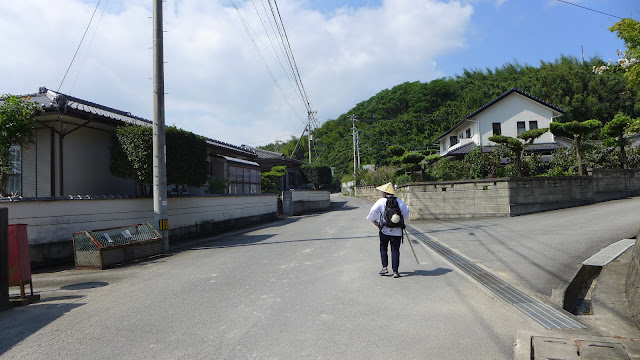The map said the distance from Gokuraku-ji to the next temple Konsen-ji was 2.6 kilometres.
I looked forward to the slightly longer distance -- so far it had been a pleasant walk and the
semi-rural views of small towns were a welcome change from the usual cityscapes of urban,
modern Japan.
The nice ladies at the temple office in Gokuraku-ji told us to keep off the (boring) highway and
walk along the back roads. We found their recommended turn a few hundred meters away,
well marked with a jizo in a small altar and the now familiar wooden directional post.
Pork in the Road comes to a fork in the road!
As I paused to check which path to take, a man came running out of his house and motioned me
to go straight ahead, after which he promptly went back inside.
We did not exchange any words, just a bow and a smile but I felt the warm consideration in this gesture. We would experience other acts of kindheartedness such as this from random people we would meet in the next several days.
Perhaps it does help to identify yourself as a henro, by wearing the henro attire.
The locals look out for you and help you when you least expect it.
Just 1.6 kilometres to go! On the far left you can see a portion of the highway which was marked on our map as the route to the temple. Thanks to the intervention of the helpful ladies at Gokuraku-ji, we took the better way.
If we had walked along the highway, I would not have met this friendly shiba inu who came running out when he saw us walking by. He peered at us from the fence and wouldn't leave even after we had walked on.
These wooden markers remind me of the mogotes of the Camino de Santiago and the cement posts along the Kumano Kodo. Markers and directional signs are prevalent along the roads of Shikoku, they can come in different forms -- some are just stickers placed on walls or even lampposts.
Before we knew it, we had reached Konsen-ji. The Niomon gate made a bright contrast to the green foliage of the hills behind it. I can understand why autumn is peak pilgrimage season in Shikoku -- these hills must be a riot of fall colours, quite beautiful to behold.
The main buildings inside the temple grounds are the Hondo on the left and the Daishido, marked with a golden Buddhist emblem on top.
Do you see the red bridge beside the various statues? It leads to a small pavilion and a pagoda in
the back.
On the morning we visited, there were students from the local high school who were performing
o-settai or "charitable gift giving" for henro. They gave us cups of refreshing green tea.
Because they had given us o-settai, Jay and I reciprocated by giving them an omiyage or a present. Before we left for this pilgrimage, I had ordered hand made, hand painted fans from my friend Victor to be given to people we would meet along the way.
I asked him to draw a lotus flower as the lotus or hasu is associated with Buddhism and Kobo
Daishi. I could not give each and every student a fan but their teacher gladly accepted one on behalf of their class.
Coincidentally, I found a single violet lotus flower growing from the Konsen-ji's lotus pond.
It looked like the lotus on our fan -- I think Kobo Daishi approved of our omiyage.
It was a hot day and almost noontime so we enjoyed a cool respite in the temple's air conditioned office. The lady graciously agreed to have her photo taken as she inscribed our nokyocho.
Henro etiquette 101 -- always please ask before using your camera as not everyone wants to have their photo taken.
I ordered the fans with the specific thought of giving them to the monks and the temple staff in the
nokyocho office. They always responded with surprise and pleasure and we would receive o-settai
in return.
The people in the nokyocho office were also the ones who would invariably give us very definite directions to the next temple. And even if most of them could only speak very little english, we always managed to understand each other.
After all, kindness and helpfulness are universal languages that we can all communicate in.
P.S
Unfortunately, we were not able to take a photo of the pavilion as sketched on the nokyocho but this is Konsen-ji's seal and stamp along with a photo that I took of the Daishido.













No comments:
Post a Comment